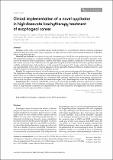Clinical implementation of a novel applicator in high-dose-rate brachytherapy treatment of esophageal cancer

View/
Author
Friesen, Scott
Harris, Thomas C.
Published Version
https://doi.org/10.5114/jcb.2016.61933Metadata
Show full item recordCitation
Buzurovic, Ivan M., Jorgen L. Hansen, Mandar S. Bhagwat, Desmond A. O'Farrell, Scott Friesen, Thomas C. Harris, Antonio L. Damato, Robert A. Cormack, Neil E. Martin, and Phillip M. Devlin. 2016. “Clinical implementation of a novel applicator in high-dose-rate brachytherapy treatment of esophageal cancer.” Journal of Contemporary Brachytherapy 8 (4): 319-325. doi:10.5114/jcb.2016.61933. http://dx.doi.org/10.5114/jcb.2016.61933.Abstract
Purpose In this study, we present the clinical implementation of a novel transoral balloon centering esophageal applicator (BCEA) and the initial clinical experience in high-dose-rate (HDR) brachytherapy treatment of esophageal cancer, using this applicator. Material and methods Acceptance testing and commissioning of the BCEA were performed prior to clinical use. Full performance testing was conducted including measurements of the dimensions and the catheter diameter, evaluation of the inflatable balloon consistency, visibility of the radio-opaque markers, congruence of the markers, absolute and relative accuracy of the HDR source in the applicator using the radiochromic film and source position simulator, visibility and digitization of the applicator on the computed tomography (CT) images under the clinical conditions, and reproducibility of the offset. Clinical placement of the applicator, treatment planning, treatment delivery, and patient's response to the treatment were elaborated as well. Results: The experiments showed sub-millimeter accuracy in the source positioning with distal position at 1270 mm. The digitization (catheter reconstruction) was uncomplicated due to the good visibility of markers. The treatment planning resulted in a favorable dose distribution. This finding was pronounced for the treatment of the curvy anatomy of the lesion due to the improved repeatability and consistency of the delivered fractional dose to the patient, since the radioactive source was placed centrally within the lumen with respect to the clinical target due to the five inflatable balloons. Conclusions: The consistency of the BCEA positioning resulted in the possibility to deliver optimized non-uniform dose along the catheter, which resulted in an increase of the dose to the cancerous tissue and lower doses to healthy tissue. A larger number of patients and long-term follow-up will be required to investigate if the delivered optimized treatment can lead to improved clinical outcomes.Other Sources
http://www.ncbi.nlm.nih.gov/pmc/articles/PMC5018528/pdf/Terms of Use
This article is made available under the terms and conditions applicable to Other Posted Material, as set forth at http://nrs.harvard.edu/urn-3:HUL.InstRepos:dash.current.terms-of-use#LAACitable link to this page
http://nrs.harvard.edu/urn-3:HUL.InstRepos:29407569
Collections
- HMS Scholarly Articles [17922]
Contact administrator regarding this item (to report mistakes or request changes)


